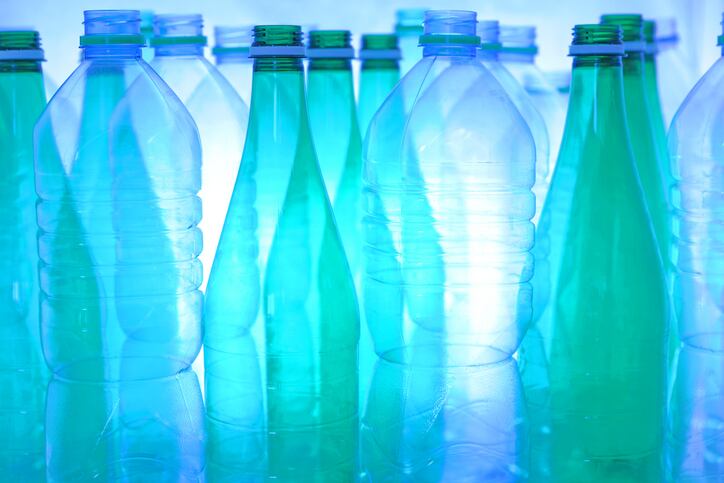What would a world look like without plastic? It’s a question that’s difficult to answer, because the material everywhere. That’s the same for the beverage industry: while there may now be plenty of other formats for consumers to choose from, plastic is still an ever-present force.
Can the beverage industry move completely away from plastic bottles - and how could we transform this idea into reality?
There are two main steps. Firstly, plastic needs to go. But the second step is more revolutionary and offers beverage companies a way to step in and lead the change with innovation.
Why plastic is not fantastic
One trend that has been consistent across the beverage industry over the last two decades is a backlash against plastic bottles. It’s a subject that continues to gain regular and frequent media attention. Most consumers are abundantly aware: plastic is bad.
The problems with plastic bottles come from the resources (oil and gas) they use from the earth; then the fact they are single-use items which are designed to be used once then discarded into landfill or oceans where they last for centuries.
And there are other concerns. There’s the impact of plastic on the soil and air quality, and on human health. Microplastics have been found in human blood, placenta, brains (a recent study found that humans brains now contain around a spoon’s worth of microplastics). The volume of microplastics in bottled water have now been well-investigated by many studies: nanoplastics are raising equal concerns.
In the beverage industry, plastics are everywhere. Of course, that includes bottled water, but it also reaches across categories to those many consumers are not even aware of (such as as a sealant in plastic bags).
One of the reasons they have persisted in the beverage industry (and indeed across the industry) is their advantages. They’re lightweight and cheap, and now so common across our lives that consumers think little of the packaging itself.
And that’s the problem: the mentality of society, from consumers to industry, needs to change.
Whose problem is it anyway?
Consumers say they hate plastic: but they still buy it. Industry says it’s reducing plastic usage through lightweighting and exploring alternative formats such as cans: but it’s still using it. Governments might be exploring regulation (such as the EU’s Packaging and Packaging Waste Directive or the UK’s Extended Producer Responsibility scheme), but they still allow plastic to be used on mass.
Asking who’s responsibility plastic is will get us nowhere (inevitably, the correct answer would be ‘we all have a part to play‘).
The most important question, instead, is to ask who has the power to catalyze a shift away from plastic.
“It is most definitely governments that need to promote better legislation to protect the environment and people’s health,” said Sian Sutherland, co-founder of A Plastic Planet, which was founded in 2016 to take a ‘pro-business, pro-solution’ approach to the world’s plastic problem.
“Unfortunately, industry will never change until there is a legal requirement for them to do so. Industry’s reliance on fossil fuels and plastic production is entirely driven by cost and profit. Governments should make it their obligation to build on the vast research already available, outlining the overriding dangers of plastic on the environment and our health, to draw up a roadmap that aims to eradicate plastic once and for good.”
And this government shift may be coming sooner than you think.
“A Plastic Planet have already created a roadmap for the UK Government to enact stepwise, simple policies to tackle this crisis,” said Sutherland.
“This roadmap helps give business certainty and leads the UK to a thriving post plastic economy. In August, we will be calling on UN delegates to support a strong and comprehensive UN Plastics Treaty that will provide certainty to business that change is not up for debate.”
And it’s also in the industry’s interest to change. “It is hugely risky for business to continue with plastic now we have so much irrefutable evidence from the health scientists of the human health impact of the chemicals and plastic particles that infect our bodies,” says Sutherland.

Is rPET the solution?
Beverage giants such as Coca-Cola have made much of their recycling goals and bold ambitions to include more recycled PET (rPET) in products.
That turns plastic from a single-use material into one with multiple lives and uses (even if obtaining food-grade rPET can be a problem, rPET from beverage brands can be then be used in lower quality, non-food grade products).
And yet rPET simply carries the problems with plastic from one plastic bottle to another, says Sutherland, who is firm that rPET is not the answer.
“We have been sold a myth that recycled plastic is remotely better for us and the environment,” she said. “This is based on entirely unfounded claims, made to manipulate consumers into continuing to buy plastic.

“In reality, recycled plastic, including PET bottles, pose an even greater threat to the planet and our existence because recycling plastic is an inherently risky process. The thousands of chemicals we use to make plastic, largely unregulated, do not disappear in the recycling process. In fact, they compound up.
“In addition, through cross-contamination and heating, it can lead to the creation of unknown, and of course unregulated chemicals, also known as NIAC (Non-Intentionally Added Chemicals). Once these are created they are destined to end up dispersed in the environment, blocking photosynthesis in plants, for example, and in our own bodies, putting us at greater risk of chronic illnesses.”
Recycling headaches
Plastic is notoriously difficult to recycle: requiring meticulous sorting while quality degrades each time a product is recycled.
A 2024 report from fossil-fuel accountability advocacy group the Center for Climate Integrity (CCI) claimed that Big Oil and the plastic industry 'have deceptively promoted recycling as a solution to plastic waste management for more than 50 years, despite their long-standing knowledge that plastic recycling is not technically or economically viable at scale '.
Advantages of plastic
Is plastic really that bad? The packaging format has been well and truly demonized: yet it still offers great advantages to food and beverage manufacturers. It helps reduce food waste, by keeping foods fresher for longer. And it is light: meaning less emissions during transportation of finished goods than for other formats such as glass.
These are arguments that were taken up by The Economist recently. ‘Plastics are greener that they seem’, declared the publication: a provocative headline to lead the argument that the economic benefits of plastic and problems with alternatives (glass and cans have higher greenhouse-gas emissions than plastic, it says) keep plastic as a winning format. Citing the potential of better waste management, The Economist concludes that ‘plastics still have a great future’.
But Sutherland does not believe that the benefits plastic offers in keeping food fresh and reducing transportation weights are valid.
“My answer is that this is again the product of a narrative that has been created by Big Oil to promote plastic production,” she said. “Right now, plastic is the miracle material, but that’s because corporates have not found it necessary to truly invest in other new materials that are increasingly on the market and becoming the new alternatives.
“We can’t ignore the environmental and health impact of plastic just for the sake of its effectiveness in delivering certain metrics. There are other solutions.”
The three steps to changing the plastic world
1. Law: Governments would mandate moves away from plastic
2. Risk: Industry needs to wake up to the 'contingent liabilities they need to be reporting on their balance sheets and enlightening shareholders if they continue to use plastic now we know its true impact', says Sutherland.
3. Innovation: Switch the conversation from a negative one about bans to positive ones about new innovations. "We have been incredibly lazy in our material innovation for 50 years... imagine if just a fraction of the billions of dollars that have been invested in plastic innovation over the last decades were now to be spent on new natural materials, using bio-technology and AI to fast track solutions," says Sutherland.
Innovation opportunity
Plastic is so ingrained in our society it’s difficult to think of it differently. It’s the same with single-use materials: which are a convenience that have become second-nature.
And yet, that doesn’t mean it always have to be this way. Times have changed: and so should our packaging.
Sutherland is not just a campaigner. She was also named Entrepreneur of the Year and British Inventor of the Year and is an entrepreneur with a varied background in advertising, skincare, Michelin Star restaurants, film production, and brand creation design agencies. And she knows an opportunity for innovation when she sees one.
“Plastic is last century’s material because it was designed for a linear economy, last century’s economy, that prioritized convenience over environmental and health concerns,” she said.
“The innovation opportunities for beverage packaging extend far beyond simply replacing plastic with another material. We need to look at the entire system and see the opportunities to reduce material resource and energy usage.
“The future lies in developing truly nutrient-based alternatives such as molded fiber using agri-waste, plant proteins, fermented microbe technology, marine-based materials - all fully circular as we keep their nutrient state throughout the entire life cycle so nature can take them back safely,” said Sutherland.
“We should be expanding infinitely recyclable aluminium and steel usage, and creating smart returnable systems with embedded technology for tracking and consumer reward.
The beverage brands living in the future
PepsiCo's SodaStream has built its at-home soda machine globally; while companies ranging from Carlsberg Britvic to Belu are working on beverage dispenser systems.
Waterdrop focuses on small, concentrated beverage cubes; as does Bumpin Blends and Dice.
“Companies that pioneer these alternatives won’t just be addressing environmental concerns but positioning themselves advantageously as regulations inevitably tighten.”
Instead of resisting change, Sutherland urges beverage brands to treat this as an opportunity for innovation.
“We need to reinvent from the very conception of a product. Why are we shipping drinks that are 90%+ water around the world when we can ‘just add water’ at the point of usage? Brands such as Plink! are developing this new category of drinks with high growth potential, delivering healthier beverages with far less negative impact.
“The beverage industry has a unique opportunity to lead this transformation rather than resist it. Companies that embrace innovative packaging solutions now will likely gain competitive advantages as regulations tighten and consumer awareness grows. Investment in plastic alternatives shouldn’t be seen as a cost but as future-proofing against inevitable regulatory changes and shifting consumer preferences.
“Ultimately, moving beyond plastic bottles requires rethinking our relationship with packaging altogether.”

